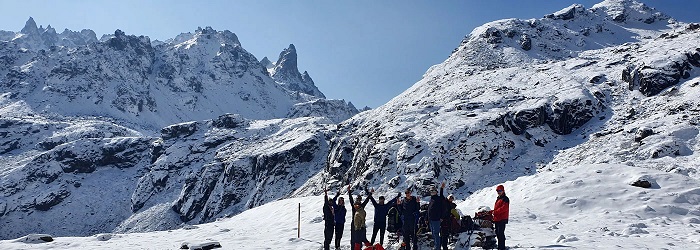The opportunity to trek around Kanchenjunga attracts many travelers. It is worth knowing more about this route.
If you are planning to trek in Nepal, there is no doubt that you haven’t come across the grandeur of the Kanchenjunga Circuit Trek. Likewise, if you have heard of this journey, you might have come to know that this particular trek takes you through off-the-beaten trails in a remote and rugged setting.
Now, if you are an adventure seeker, the Kanchenjunga Trek must be on your bucket list. So, to fulfill your dream trek, have you thought about when to embark on this journey? In fact, what is the best time for the Kanchenjunga Circuit Trek?
To ensure that you get the most out of your journey, it is important to understand the seasonal variations of the trek. As the Kanchenjunga Trek passes through remote villages, dense forests, and rugged terrain, it is crucial to know if the season you are traveling in will expand your trek’s horizon or further add up to its challenges.
It is indeed true that your experience on this trekking trail can vary significantly depending on the time of year you choose to embark on it. Each season casts a unique spell on the trek, transforming the landscapes and influencing the trekker’s experience in different ways.
From vibrant colors of the Spring, crystal clear blue skies of the Autumn, fresh landscapes of the Monsoon, and the white kingdom during the Winter – your choice of timing not only affects the weather or the views you will encounter but also adds up an extra challenge or enjoyment to the journey.
Therefore, as a trekker, you must understand the nuances of each season to make an informed decision and tailor your trek to match your preferences.
Seasons In The Trails Of Kanchenjunga Trek
Like any other space you visit, the Kanchenjunga region also has four main seasons – Spring, Autumn, Summer / Monsoon, and Winter. Here, each season brings a variation in the experience of the journey offering challenges and enjoyment.
Thus, let us explore the Kanchenjunga trek through the lens of its different seasons, highlighting what trekkers can expect and how to prepare. So, lace up your boots, and let’s take a closer look at what each season has to offer on the Kanchenjunga trek.
Spring (March to May)
As the Winter’s snow slowly starts to recede, the Spring season begins to breathe the region back into its life, transforming it into a vibrant tapestry of colors. There is no doubt that the Spring season is arguably one of the most enchanting times to undertake the Kanchenjunga trek.
Well, it is the peak season and most trekkers are enchanted with the colorful blooms and lush greenery. During this time of the year, the trekking trail is filled with rhododendrons, magnolias, and orchids, creating a spectacular floral display.
One of the interesting factors of the season is that; the lush greenery not only attracts the trekkers but also the various wildlife. Spring brings the highest probability to witness fauna of the region including the Himalayan tahr, red panda, and numerous bird species like the Himalayan Monal and the Snow Pigeon.
Moving on, this season also brings mild and pleasant weather. Generally, the daytime temperatures at lower altitudes can range from 10°C to 20°C, while at higher elevations, temperatures can drop to around 5°C to 10°C. Comparatively, the nights can be chilly, especially at higher camps, with temperatures ranging between -5°C to 5°C.
Altogether, the weather is usually stable with less likelihood of precipitation, offering clear skies and abundant sunshine. During this time of the year, the air is generally clean and clear, offering unobstructed vistas of Kanchenjunga and its surrounding peaks. Likewise, the trails are usually in good condition.
While you may encounter patches of snow during early Spring on some parts of the trail, the overall trekking route is relatively dry with fewer obstacles. However, some parts may get dangerous with the swollen streams or rivers due to the melting of the snow.
All in all, due to the favorable conditions of the season, you can expect a good amount of crowd, therefore, NTE advises you to book lodges and permits in advance to secure a spot and avoid the rush.
Pros
- Mild and pleasant weather with clear skies.
- Stunning floral displays and vibrant landscapes.
- Excellent clarity of mountain views.
- Wildlife sightings are more common.
Cons
- Higher number of trekkers.
- Accommodation may be in high demand.
- Nights can still be quite cold at higher altitudes.
Summer / Monsoon (June to August)
As the Spring season comes to an end, the Kanchenjunga Trek takes a totally dramatic turn with heavy downpours. While it does offer a unique perspective and experience of the trek, this season is less frequented by the trekkers.
The Monsoon brings a lush transformation to the trails as the flora of the region gets more green. You will see some blooming flowers but it will not be as abundant as during the Spring.
Moving on to the temperature, the lower elevation ranges from 20°C to 25°C, while at higher altitudes, temperatures drop to around 10°C to 15°C during the day. Nights can be quite cool, with temperatures falling from 5°C to 10°C.
However, the frequent rainfall makes the trek less comfortable and the mist and clouds often block the views. Thus, you will have little to no visibility of the surrounding peaks which will be a huge disappointment if you are especially up for photography.
Similarly, the constant shower makes the trail muddy and slippery, demanding more skill and endurance to complete the journey. On a similar note, the Monsoon brings the risk of landslides in the lower region disrupting the roadways. Likewise, the heavy clouds also disrupt the airways causing unforeseen cancellation of the plans.
Having said that, Monsoon gives an opportunity to have a solitary experience as there will be a decrease in foot traffic.
Pros
- Lush, verdant landscape with rich greenery.
- Fewer trekkers and a more solitary experience.
- Lower demand for accommodation.
Cons
- Heavy rain and high humidity make trekking uncomfortable.
- Reduced clarity of mountain views due to cloud cover.
- Risk of landslides and difficult trail conditions.
Autumn (September to November)
With months-long rainfall, the region takes a calming break with Autumn offering spectacular after-shower scenery. During this season, the valley adorns itself with shades of gold and red as the leaves change color.
Alongside the colorful valley contrasting with the white background of snow-capped peaks, Autumn brings crisp air, making it a favorite among trekkers. This stable weather and fresh air also contribute to some of the clearest and most breathtaking views of Kanchenjunga and the surrounding peaks.
This unobstructed view gives an excellent photography moment while the contrasting colors of the landscape and backdrop make it a prime time for capturing the majestic beauty of the Himalayas.
Autumn is indeed a pleasant change from the Monsoon season as the daytime temperature at lower elevations ranges from 15°C to 20°C, while at higher altitudes, temperatures are around 5°C to 10°C. Additionally, the nighttime temperatures can drop to -5°C to 5°C.
Here, as most of the Monsoon rain has dried up, the trails are also more stable offering a comfortable experience. Altogether, due to its favorable conditions, the trek gets much busier. Hence, to avoid last-minute hassles, you should plan ahead and book lodges and permits in advance to secure spots.
Pros
- Stable weather with clear skies.
- Exceptional clarity of mountain views.
- Dry and stable trail conditions.
Cons
- Higher number of trekkers.
- Increased demand for accommodation.
- Higher costs due to peak season rates.
Winter (December to February)
The Winter season transitions the Kanchenjunga Trek to a white kingdom covered in a heavy blanket of snow. Indeed, the exceptional beauty of the snow-covered trails and peaks is captivating.
Additionally, this cold, dry weather makes a beautiful contrast between the bright snow and the clear blue sky. However, the freezing temperature makes the trek much more challenging.
Here, the daytime temperatures at lower altitudes can range from 5°C to 10°C, while at higher elevations, temperatures often drop below freezing. Likewise, nighttime temperatures can plummet to -15°C to -5°C. Due to this cold temperature, most flora and fauna of this region get dormant. You can get rare sightings of wildlife such as snow leopards or other winter-adapted species.
As for the trail conditions, Winter trails are typically covered in snow which makes the navigation more difficult. Furthermore, due to the harsh weather conditions, some lodges and services at higher altitudes may be closed.
Herewith, while the snow adds extra beauty to the region, it also brings hazardous conditions which result in very few trekkers on the trails. Nepal Trekking Experts do not recommend the Kanchenjunga Trek during Winter.
Pros
- Stunning snow-covered landscapes.
- Fewer trekkers and a peaceful experience.
- Unique winter trekking adventure.
Cons
- Extremely cold temperatures and challenging conditions.
- Snow-covered trails can make navigation difficult.
- Limited availability of accommodations and services.
Conclusion
While Autumn and Spring are the peak seasons for the Kanchenjunga Trek due to its optimal condition, each season offers its own unique experience, and the best time to visit depends on your preferences and readiness for the conditions.
Therefore, it is crucial to understand the characteristics of each season to help you choose the ideal time for your adventure.















